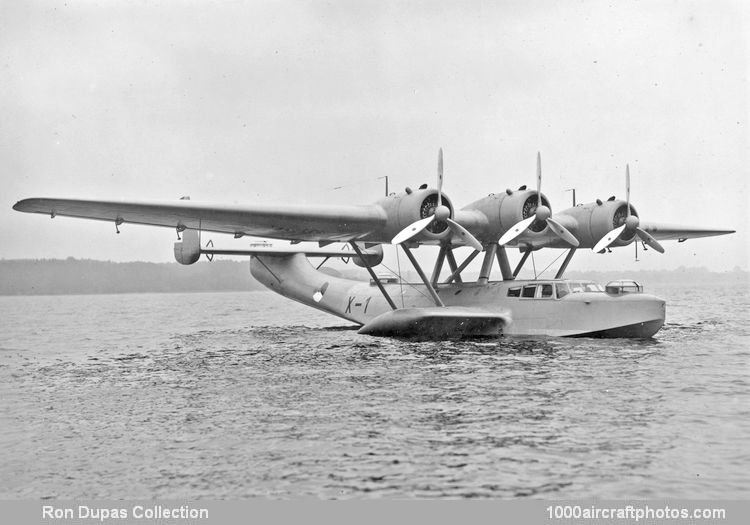Three prototypes were built, the third, the Do 24 V3, being intended as the prototype of the export model, was actually the first to fly. The initial test flight took place on July 3,1937, power being provided by three 890 hp Wright R-1820-F52 Cyclone radials. The Do 24 V1 did not fly until January 10, 1938, this aircraft being powered by three 600 hp Junkers Jumo 205C diesel engines as was also the Do 24 V2. Both the Do 24 V1 and V2 were later to participate in the invasion of Norway, a 0.311 in (7.9 mm) MG 15 machine gun being installed in the bow and tail positions and a 0.787 in (20 mm) MG 151 being housed in a power-operated dorsal turret. Twelve 110 lb (50 kg) bombs could be carried under the wings.
The Do 24 V3 was delivered to the Netherlands late in 1937, and a further eleven Cyclone-powered machines were built by Weser Flugzeugbau under the export designation Do 24 K, these being delivered to the Dutch Navy during 1938-39. A manufacturing license for the Do 24 K was acquired by the Dutch government, the Aviolanda company building the fuselages and the De Schelde company manufacturing the wing assemblies. Dutch production deliveries commenced early in 1939, 25 of an order for 48 having been delivered by the time the Netherlands were invaded, and a number of aircraft were in service in the East Indies when the Pacific War began. On December 23, 1941, five of the Do 24 K flying boats were destroyed in an attack on Davao in the Philippines, and three days later four more Do 24 Ks were destroyed at the moorings on Tonduno Lake by strafing Japanese fighters.
Five Do 24 Ks used for training at Morokrembangan, near Surabaya, were flown to Australia in February 1942, and during the following month, the surviving operational Do 24 Ks were also transferred to Australia. Two made forced landings en route, one being destroyed, but the remaining four reached Broome, being sunk at their moorings there in a Japanese air attack on March 3, 1942. Five of the Do 24 Ks originally used for training were taken over by the RAAF (under the designation A-49), and the sixth Do 24 K, which had survived the Broome attack as a result of a fuel shortage which had necessitated a forced landing at Wallal while en route to Broome, was used by the Netherlands Forces Intelligence Service on clandestine operations until it was handed over to the RAAF in October 1943.
The Do 24 Ks still under construction in the Netherlands at the time of the German occupation were transferred to Germany, re-equipped, and employed on air-sea rescue duties under the designation Do 24 N-1. Production of the Do 24 was continued in the Netherlands after the occupation, Weser Flugzeugbau supervising the program, sixteen being completed in 1941 under the designation Do 24 T. The Do 24 T-1 and T-2 were intended for both maritime reconnaissance and transport roles, and differed solely in internal equipment, both being powered by 1,000 hp BMW/Bramo Fafnir 323R-2 nine-cylinder air-cooled radial engines. Armament was identical to that of the Do 24 V1 and V2. During 1942, the former CAMS (Chantiers Aéro-Maritimes de la Seine) plant at Sartrouville, France, was brought into the Do 24 T program, delivering two flying boats in that year.
A total of 154 Do 24 T flying boats was completed in the Netherlands from 1942 until the liberation, and the Sartrouville plant produced a further 46, although not all of these were received by the Luftwaffe as some unfinished machines at Sartrouville at the time of the German withdrawal were completed for the French Navy, Flottille 9F Tr (Transport) being formed on December 5, 1944, to operate these aircraft. The first two Do 24 flying boats for Flottille 9F were delivered from Sartrouville to Saint Mandrier on December 29, 1944, and in January 1945 twenty Do 24s were under construction at Sartrouville for the French Navy, these subsequently serving in the transport role with Flottille 9F until January 1, 1946, when that unit became Escadrille 30S. The Do 24s served with Escadrille 30S in the air-sea rescue role and performed similar duties with Escadrille 20S, the latter unit being disbanded in October 1949. Escadrille 30S continued operating Do 24s until disbanded on January 15, 1952, and the last flying boats of this type in service with the French Navy were operated by the flying boat pilot's school at Karouba, Escadrille 53S, until sold to Spain in 1953.
One Do 24 T-1 entered service with the Royal Swedish AF, this particular aircraft having made a forced landing at Hällevik, Sweden, on October 31, 1944. As the Swedes had no aircraft suitable for the air-sea rescue role, the Do 24 T was taken over by the Royal Swedish AF as the Tp 24, compensation being paid to Germany. There was an agreement that all German aircraft and ships in Sweden at the end of the war that had left the area of Germany that was to become the Russian Zone were to be handed over to the Soviet Union, and it is an interesting corollary to the story of the sole Swedish Do 24 T that the aircraft was eventually claimed by the Soviet Union, a Russian crew arriving in Sweden to ferry the aircraft to the USSR in August 1951! In the spring of 1944, twelve Do 24 T-3s were purchased by the Spanish government to equip an air-sea rescue squadron subsequently based at Pollensa, these flying boats remaining in service until the 1970s."
The following data relate to the Do 24 T.
